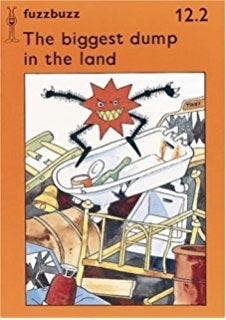In these post-Literacy Hour times we live in, hearing children read has become a somewhat unfashionable activity, particularly in junior schools where this task is delegated to the teaching assistant while the teacher gets on with the real essence of teaching: filling in grids and interpreting sheets of statistical analysis about pupil performance. Many children get their daily dose of reading through “extracts” and “texts,” usually projected upside down on an overhead projector by the slightly hung-over teacher.
There is still some one-to-one reading but as this is with underperforming pupils it is often from reading scheme books. As a teacher, there is no sight more guaranteed to cause despair than a child shuffling towards your desk bearing a dog-eared copy of “Land of the Dinosaurs” and plonking it on your desk with a sigh. Like most reading books, it sounds like a potentially exciting tale but that struggling year 4 reader is unlikely to thrill to a tale where the high point is that some children see a dinosaur and run away. He’s probably seen Jurassic Park (which, if I was being cynical, I might venture to suggest he watched on the TV/DVD combo balanced at the end of his bed on top of an empty bookshelf), so he’s expecting at least one character to have their head removed bloodily from their shoulders.
After several years of listening to these books, most teachers know them off by heart. Indeed my wife is mystified and slightly disturbed as to why during my fitful night’s sleep I am often heard to moan “and the magic key began to glow...” The text of some of these books can achieve an almost hypnotic simplicity on the hundredth hearing. If I ever take up meditation, my mantra will be “Floppy-falls-in-the-river-Floppy-gets-wet.”
These books can provide some entertainment for the weary teacher. My favourite ever reading scheme book was called “The Biggest Dump in the World”. It would be a deeply twisted and sad individual who found puerile humour in that title but I am pleased to report that a scan of the front cover remained the screensaver on my school laptop for many years.
Much of the difficulty with these titles comes from trying to discuss the subject matter with ten year-old children whose main interests are mobile phones, ninja killers and dolls dressed in outfits that most prostitutes would regard as “a bit tarty.” The adventures of some children who find a wallet and return it to its owner just doesn’t “do it” for them.
Further down the school, children can still derive a lot of pleasure from these tales. Recently, however, their reading skills have been supplemented by a new device to help adults doubt their sanity: “action phonics.” I seem to be able to read and write to a reasonable standard but when I pronounce “L” I simply say “luh” and see no need to accompany the sound with a frenzied licking action. Every school seems to have taken these up with great glee: wobbling like a jelly for “J”; imitating someone watching tennis for “T”; and sticking up two fingers for “F.” I’m sure these activities have a great positive effect on learning but it does mean that a reading lesson in Reception class can resemble a group of “shakers” undergoing a religious experience, the poor teacher cowering in the corner covered in dribble as her class “B” to their hearts’ content. Hopefully my son’s teacher will be cheered up when she opens up his “sound book” tomorrow and sees the large picture of General Pinochet I’ve stuck next to “pear” and “pen” on the “P” page.

